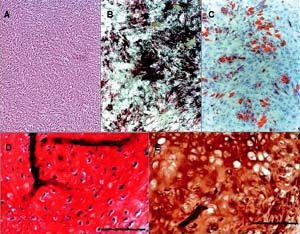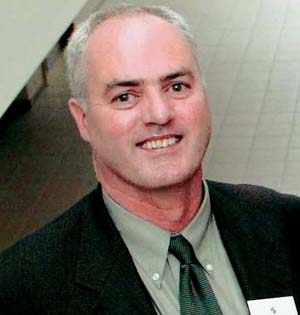| 2004 |

|
YEAR BOOK |
National University of Ireland, Galway
|
Regenerative Medicine Institute
|


Adult human stem cells have been isolated from a wide variety of tissues and, in general, their differentiation potential may reflect the local environment. They lack tissue-specific characteristics but, under the influence of appropriate signals, can differentiate into specialized cells with a phenotype distinct from that of the precursor. It may be that stem cells in adult tissues are reservoirs of reparative cells, ready to mobilize and differentiate in response to wound signals or disease conditions. Little information is currently available about the biology of endogenous stem cell populations in adults and their precise role in tissue repair or regeneration. This may be due in part to the lack of useful cell-specific markers. What is clear, however, is the ease with which these cells can be isolated and expanded in culture through many generations, while retaining the capacity to differentiate. Recent progress in the isolation and characterization of these cells has led to the development and testing of therapeutic strategies in a variety of clinical applications.
Mesenchymal stem cells (MSCs), which reside within the stromal compartment of bone marrow, have the capacity to differentiate into cells of connective tissue lineages, including bone, fat, cartilage and muscle. In addition, they play a role in providing the stromal support system for blood stem cells in the marrow. MSCs represent a very small fraction, 0.001�0.01% of the total population of cells in marrow. However, they can be isolated and expanded with high efficiency, and induced to differentiate to multiple lineages under defined culture conditions. These cells have generated a great deal of interest because of their potential use in regenerative medicine and tissue engineering. Both pre-clinical and clinical studies offer dramatic examples that illustrate the therapeutic value of MSCs. While the therapeutic testing of these cells has progressed well, there are still many questions to be addressed concerning the role of endogenous populations of stem cells in the adult, and the function of various stem cell niches. In addition, there are several aspects to the implanted cell-host interaction that need to be addressed as we attempt to understand the mechanisms underlying these therapies.

Although early pre-clinical and clinical data demonstrate the safety and effectiveness of MSC therapy, there are still many questions to be answered surrounding the mechanism of action. Additional information is required concerning the therapeutic efficacy of transplanted cells and the mechanisms of engraftment, homing and in vivo differentiation. There is also a need to carry out appropriately designed toxicology studies to demonstrate the long-term safety of these therapies. The widespread use of stem cell therapy will also depend upon the availability of validated methods for large-scale culture, storage and distribution. In addition, there is a need for novel engineered devices for tissue-specific delivery of cells, such as cell-coated stents and catheter-based delivery in cardiovascular applications, and arthroscopic delivery in the treatment of joint disease. As these areas are addressed, new applications will be developed leading to novel therapeutic opportunities. Much has been learned about stem cell therapy in the past few years, and much remains to be learned.
Contact: Dr Frank Barry, Scientific Director, Regenerative Medicine Institute,
National Centre for Biomedical Engineering Science, National University of Ireland, Galway;
Tel: +353-(0)91-512636; Fax: +353-(0)91-750-596; E-mail: [email protected]